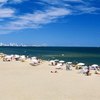Costa Rica, a small country in southern Central America, is home to a number of ecosystems and landforms, all containing astounding biodiversity. Despite the country's size, from the mountains on its Pacific coast to the Caribbean beaches that make it a popular travel destination, Costa Rica features sights and activities for every interest. Whether you're particularly interested in a specific destination or want to see everything the country has to offer, understanding the broad variety of landforms can help in planning an unforgettable trip.
Mountains and Volcanoes
Much of Costa Rica is made up of the Sierra Madre mountain range. Most of the peeks in the country are volcanic -- more than 100 volcanoes sit within its borders -- and some of the less active spots afford hiking and climbing opportunities. Cerro Chirripo, at 12,533 feet, ranks as the country's highest point and can be scaled by intermediate and advanced climbers. Other highlights include the active Arenal volcano, with its constant lava flows, the crater lake of Irazu and the Poas volcano in the middle of a mist-filled cloud forest, with an impressive variety of bird and reptile species.
Lowlands
Between the peaks of the Sierra Madre, the central valley and northeastern coast of Costa Rica are made up of flat valleys and coastal plains. On the northeastern coast, lush forests dominate the landscape, giving way to mangroves and white-sand beaches on the coast. In the region, Tortuguero National Park offers numerous activities for travelers interested in wilderness activities like trekking, bird-watching and conservation volunteering opportunities at sea turtle nurseries. The central valley is dominated by the capital city of San Jose and the smaller towns and agricultural land that surround the capital.
Rivers
Costa Rica's rivers run mostly from the misty, forested mountains to the plains on the Caribbean and Pacific coasts, fed by abundant tropical rains. The Pacuare River flows into the Caribbean sea and offers class V rapids for experienced rafters. For beginners, the Reventazon and Tarcoles rivers also feature rafting areas. The Tarcoles River includes a large American Crocodile habitat as it nears the Pacific coast, while the Reventazon feeds the country's fertile agricultural lands in the central valley.
Beaches
For most travelers, a calm white-sand beach is the postcard image of Costa Rica. Costa Rica's beaches include surf havens on the Pacific coast, with rougher surf and tranquil Caribbean waters to the east, where parts of the coast also include coral reefs for snorkeling and scuba diving. Pacific destinations include Guanacaste and the Nicoya Peninsula, while many travelers also head to the Caribbean towns of Puerto Viejo and Manzanilla to enjoy the calm and warm waters of the Caribbean.
References
- World Atlas: Costa Rica Landforms
- Frommers: Costa Rica Regions in Brief
- Costa Rica National Parks: Irazu Volcano National Park
- Costa Rica National Parks: Arenal Volcano National Park
- Costa Rica National Parks: Poas Volcano National Park
- Costa Rica National Parks: Tortuguero National Park
- Frommers: White Water Rafting in Costa Rica
Photo Credits
- Goodshoot/Goodshoot/Getty Images




